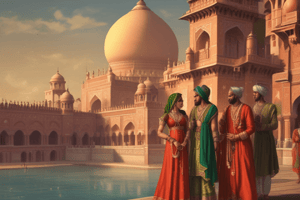Podcast
Questions and Answers
Which ruler was the last of the powerful Mughal emperors?
Which ruler was the last of the powerful Mughal emperors?
- Aurangzeb (correct)
- Akbar
- Shah Jahan
- Jahangir
The East India Company established its first factory in India in 1651.
The East India Company established its first factory in India in 1651.
True (A)
Who led the forces that ultimately did not engage in battle against Sirajuddaulah at the Battle of Plassey?
Who led the forces that ultimately did not engage in battle against Sirajuddaulah at the Battle of Plassey?
- Mir Jafar (correct)
- Tipu Sultan
- Haidar Ali
- Clive
What was the name of the village that later became known as Kolkata?
What was the name of the village that later became known as Kolkata?
After the death of Alivardi Khan, ______ became the nawab of Bengal.
After the death of Alivardi Khan, ______ became the nawab of Bengal.
Tipu Sultan was known for his close relationship with the British and for modernizing his army.
Tipu Sultan was known for his close relationship with the British and for modernizing his army.
Match the following trading companies with their countries:
Match the following trading companies with their countries:
What title was given to Company officials who returned to Britain flaunting their wealth?
What title was given to Company officials who returned to Britain flaunting their wealth?
The Mughal emperor appointed the Company as the ______ of the provinces of Bengal in 1765.
The Mughal emperor appointed the Company as the ______ of the provinces of Bengal in 1765.
Match the following figures with their titles:
Match the following figures with their titles:
Flashcards are hidden until you start studying
Study Notes
End of the Mughal Empire
- Aurangzeb, the last significant Mughal ruler, died in 1707, leading to the establishment of regional kingdoms by governors and zamindars.
Arrival of European Trading Companies
- Vasco da Gama was the first European to find a sea route to India in 1498, paving the way for Portuguese exploration and settlement in Goa.
- The East India Company received its charter from England's ruler in 1600, following the Portuguese; Dutch and French traders emerged by the early 17th century.
- Competition for lucrative goods such as cotton, silk, and spices (pepper, cloves, cardamom, cinnamon) intensified among trading companies, impacting profit margins.
Establishment of Trade in Bengal
- The East India Company's first English factory was established in 1651 on the Hugli River's banks, leading to settlement encouragement for local merchants.
- By 1696, the Company began constructing a fort, and shortly after gained zamindari rights over three villages, including Kalikata (Kolkata).
Conflicts Leading to Battles
- After Aurangzeb's death, Bengal's nawabs claimed greater autonomy, leading to tensions with the Company.
The Battle of Plassey
- Sirajuddaulah became Nawab of Bengal in 1756 but resisted Company interference, demanding cessation of political meddling and fortification.
- Following failed negotiations, Sirajuddaulah attacked the English factory at Kassimbazar, capturing officials and blockading ships.
- The Company, under Robert Clive, launched a counterattack in 1757 at Plassey, resulting in the Nawab's defeat due to betrayal from Mir Jafar, a commander.
- Sirajuddaulah was assassinated post-defeat, and Mir Jafar was installed as a puppet ruler.
Company Control Over Bengal
- By 1765, the Mughal emperor recognized the Company as the Diwan, halting gold outflows from Britain as revenues from India began financing Company operations.
Wealth of Company Officials
- Post-Plassey, smart Company officials amassed wealth and were termed “nabobs,” showcasing their riches upon returning to Britain.
- Despite some officials making fortunes, success was not universal among all Company employees.
Expansion of Company Rule
- Following the Battle of Buxar in 1764, the Company increased its interference in Indian states through appointed Residents.
- The "subsidiary alliance" forced Indian rulers to disband independent armies, relying on the Company for protection, which required substantial payments.
Resistance from Mysore
- Under leaders like Haidar Ali and Tipu Sultan, Mysore resisted Company expansion.
- Tipu Sultan halted exports of key products in 1785 and allied with the French for military modernization.
- The Company faced four significant wars with Mysore, culminating in the Battle of Seringapatam in 1799, where Tipu Sultan was killed.
Impact on Mysore
- Following Tipu Sultan's death, the Wodeyar dynasty was restored, and subsidiary alliances were imposed upon Mysore.
Studying That Suits You
Use AI to generate personalized quizzes and flashcards to suit your learning preferences.




